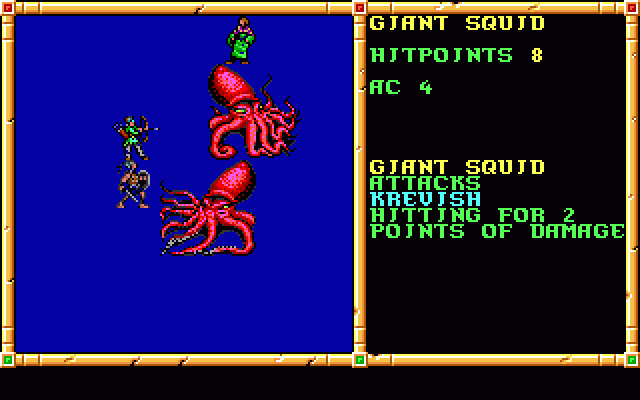|
|
|
|
|
|
|
|
|
|
|
|
As
all readers of fantasy know, the ocean floor is home to numerous ancient
submarine civilizations and dark, green realms
of creatures half-man && half-fish.
<1 shade off?, headings? harmonize, in part, or in full, with sahuagin
page>
Your
players may have heard tales of the mountains of sunken boats that have
been collected there over the centuries,
of
such things as pearls
the size of a man's head,
of
beautiful mermaids with green
eyes and blue
skin . . .
If
they should find some way to investigate these stories, how will you handle
it?
This
section deals with methods far conducting underwater scenarios.
Breathing:
The
first major concern in underwater adventures is breathable air.
Magic-users
have the advantage in this area, as they have access to several spells
that
can solve the problem of submarine respiration.
These
include water breathing (which is also a druidical spell), airy water,
shape change, or even wish,
which
might be made to work for the whole party (illusionists would use alter
reality).
They
can also polymorph others into forms that can breathe water.
However,
most non-magic-users will probably find the use of magic items or potions
safer ond more reliable.
These
include potions of water breathing
or items like the helm of underwater action or the cloak of the manta ray
(which
help in movement as well as respiration).
The
DM may also find it expedient to create such things as "air pills"
or
seaweed herbs that confer the temporary power to breathe water when ingested.
Most
methods of underwater breathing are of limited duration,
so
most submarine adventures will be similar to dungeon adventures as regards
time actually spent underwater.
Players
will have to get to their destination,
accomplish
their mission and return in a matter of turns,
rather
than days or weeks as in other outdoor adventures.
If
extended campaigns are desired,
the
DM will have to ensure that the players can acquire some sort of equipment
or comestible that will allow them to stay underwater for on unlimited
time.

Movement:
There
are two possible modes of movement underwater: swimming and walking.
Swimming
is not possible in any type of armor heavier than leather (except magic
armor),
or
when encumbered with more thon 20 pounds of equipment of any type
(add
or subtract 1 pound for each 100 g.p. worth of strength bonus or penalty).
Though
submersion in water makes everything "weigh less" due to buoyancy,
actual
mass of equipment is unchanged,
and
the same density that causes the illusion of less weight also causes a
resistance to movement that slows it down considerably. Therefore, movement
(either swimming or walking) is the same as the speeds used in dungeons,
even
though underwater movement is "outdoors".
Average
movement is a function of encumbrance in exactly the same ratios as in
dungeon movement.
Persons able to swim (due to lack of encumbrance, not innate natatorial ability) will be able to move vertically as well as horizontally, and at the same rate of speed. Remember that swimming persons ore vulnerable to attack from every direction.
Characters
encumbered with more than about 20 pounds of gear will be forced to walk
on the floor of the ocean,
lake,
river, or whatever.
They
will have to negotiate underwater hills, coral outcroppings, shipwrecks,
seaweed forests, etc., in the normal manner, i.e.,
they
will hove to go around or through them.
Characters
equipped with a ring of free action or other magic item that confers the
same power will be able to move normally and cover distance as if in the
wilderness - that is, three times dungeon rate.
Vision:
Distance
of vision will vary according to depth (available light) and obscuring
obiects.
Basically,
characters will be able to see objects and movement up to 50' away in fresh
water and 100’ away in salt water.
The
depth limit of vision is the same as the distance limit: characters can
see until they go below 50' in fresh or 100' in salt water. Below this
depth vision will be obscured.
You
may wish to vary the distance as a function of depth to make this slightly
more accurate,
so
that characters in fresh water could see 50' at a depth of 10’, 40' at
a depth of 20',
and
so on in segments of 10' until vision is 0' at 60' of depth.
The
same formula would apply to salt water, starting with 100’ of distance
at 10' of depth.
Use
of a light spell would allow vision up to 30' distance regardless of depth,
or
add 10' of vision to any distance shorter than 60' (whichever is greater).
The
visual capability of a helm of underwater action will quintuple normal
vision as pertains to both distance and depth.
lnfravision
and ultravision are useful underwater, and their distance limits are the
same as in dungeon settings.
There
are some problems, however:
infravision
users may become confused due to shifting currents and layers
of
different-temperatured water, as water exchanges heat more slowly than
air and therefore is of a less even temperature.
Distance
of ultravision is halved at 100' depth and reduced to zero below 200’ as
ultraviolet "light" does not penetrate beyond that depth in sufficient
quantities for sight.
Other
objects will also obscure vision.
Seaweed
or sea grass will reduce vision to 10' or perhaps nil for those within
it, depending on its density.
Sea
grass can be anywhere from 3' to 30' in height,
while
seaweed can take practically any size or shape the DM desires.
In
any case, shoals of either will totally obstruct vision, and anything may
be hiding within!
Schools
of fish can also blind and confuse with their masses and quick movements.
Mud
can also be a big problem, especially as pertains to combat on the bottom,
where violent movement may kick i t up in great clouds, totally blocking
vision as long as the movement lasts and for 7-12 (d6 + 6) rounds afterwards,
unless there is a current to carry it away.
Even
light sources cannot penetrate the muddiest water.
1.

Underwater
combat is difficult for normal land-born characters.
*
Due to water resistance, effective use of crushing or cleaving weapons
will not be possible --
only
thrusting weapons will be of any USE (this means spears,
tridents,
daggers, stabbing swords, etc.).
*
Human-types will also be somewhat
slowed
underwater, so aquatic creatures will always get the first
chance
to hit, unless the human is armed with a significantly longer
weapon
than the opponent.
* Only
those characters with free action ability
(from
a ring, helm or otherwise) will
be able to MOVE as if above water:
they
can use any type of weapon they could normally USE, and they receive
no
reaction penalty.
Nets
will prove useful as an adjunct to thrusting weapons underwater,
especially
if both of the combatants are swimming. There are several ways
nets
could be used.
Two
or more characters could stretch a large net between
them and foul
up
attackers or combatants by maneuvering it so that their opponents become
entangled
therein. This is most effective vs. charging or unsuspecting
opponents,
who will have less chance of avoiding it.
Nets
wielded single-handedly in combat must be weighted.
As
the net is thrown, it is given a slight horizontal spin.
The
spin causes centrifugal force to move the weighted ends out, which keeps
the net open and untangled.
If
thrown correctly, it will slow and stop spinning as it arrives at its target,
the weights then pulling the net down over the victim.
Nets
can be thrown one foot for every point of the thrower's strength.
Underwater
races can throw nets an average of 15', sahuagin
20'.
Weighted
nets can also be dropped upon non-swimmers on the ocean floor to drag them
down or incapacitate them.
Some
battle nets have little hooks or barbs attached at every intersection to
ensure that targets will be unable to escape easily.
All
of the undersea races use nets, particularly aquatic elves, locathah, and
mermen; the most adept of all are the sahuagin.
They
will often set ambushes involving many small nets or one huge net several
hundred feet in diameter.
These
may be concealed in seaweed or left floating near the surface, disguised
as something else.
The
sahuagin are masters of combat network as well, and will often fight with
a net in one hand (to entangle and confuse) and a short, jabbing trident
in the other.
The
underwater combat net is a difficult weapon to use, and player characters
who attempt it will do so at -4 to hit
(unless
they undergo extensive training and choose the underwater net as a weapon
of proficiency.
Such
training must take place underwater).
Crossbows: Except
for certain specially-made crossbows, use of missile weapons is generally
impossible underwater.
Special
crossbows which will function underwater can be made by knowledgeable bowyers
for ten times the normal price.
Effective
underwater range of these will be one-half normal (dungeon distances).
If
characters intend to go somewhere where normal missile weapons could be
of use (like the great air-filled domes of Atlantis),
bows
and missiles must be kept dry. This is doubly true of such things as scrolls
and books, of course.
Spell
USE underwater will be limited to the same ranges and distances as
in
dungeons. In addition, there are problems with spell preparation, as
many
material components will be altered by or will not work correctly
underwater.
Some spells will be altered in effects as well. Fire-based
spells
(such as fireball) will not function
at all underwater (except within
the
radius of an airy water spell). Electrical
spells will be conducted to the
entire
surrounding AREA -- a lightning bolt
will behave as a fireball,
etc.
As DM, you can alter whatever spell preparations or
effects
you deem necessary and reasonable.